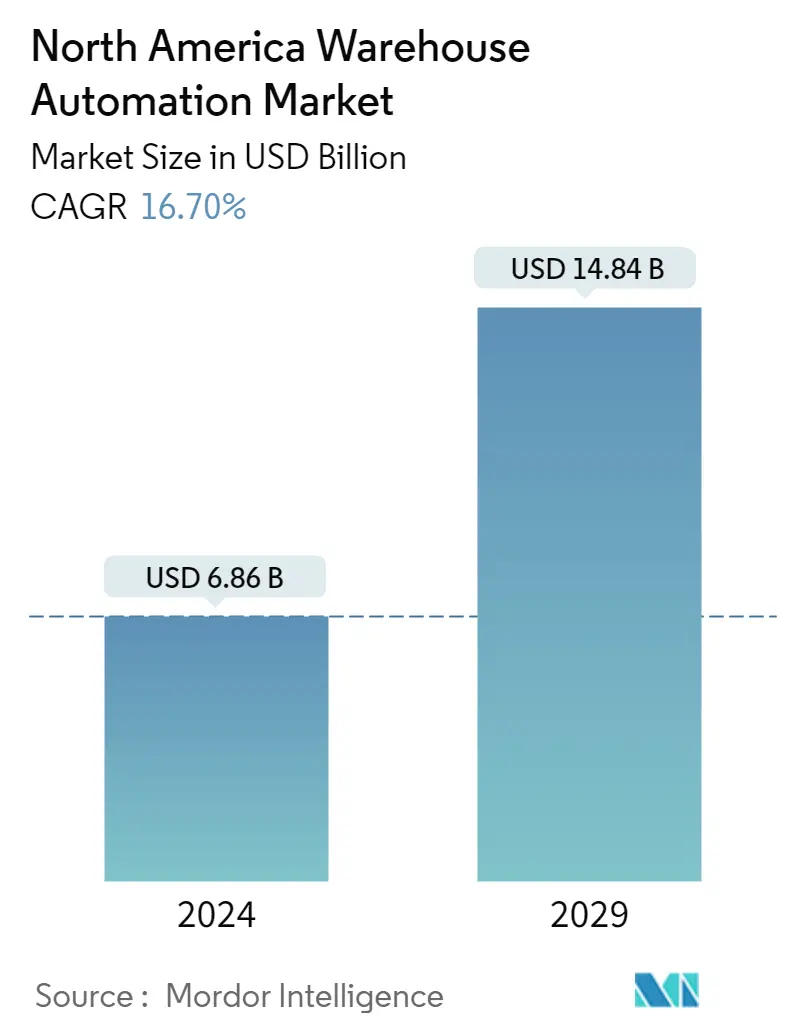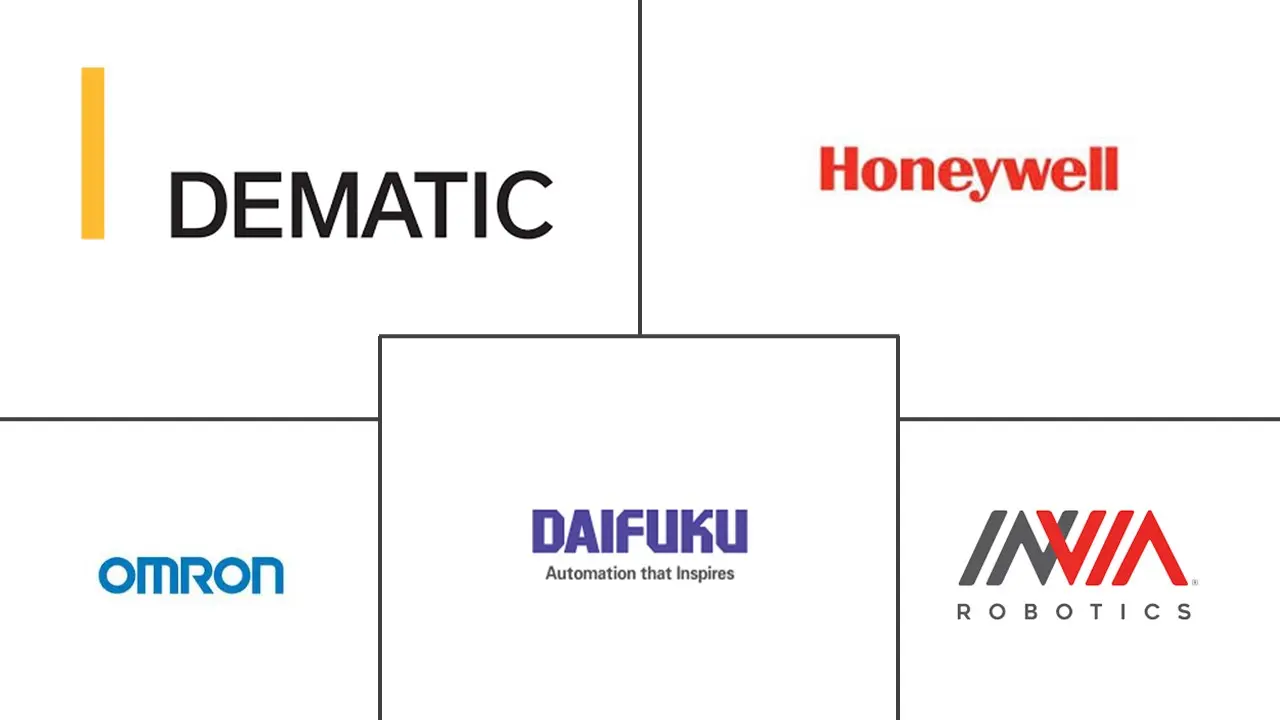Market Size of North America Warehouse Automation Industry

| Study Period | 2019 - 2029 |
| Base Year For Estimation | 2023 |
| Market Size (2024) | USD 6.86 Billion |
| Market Size (2029) | USD 14.84 Billion |
| CAGR (2024 - 2029) | 16.70 % |
| Market Concentration | Medium |
Major Players
*Disclaimer: Major Players sorted in no particular order |
North America Warehouse Automation Market Analysis
The North America Warehouse Automation Market size is estimated at USD 6.86 billion in 2024, and is expected to reach USD 14.84 billion by 2029, growing at a CAGR of 16.70% during the forecast period (2024-2029).
The use of machines, control systems, and software to increase operational efficiency by using minimal human assistance in the warehouses for inventory movement is known as warehouse automation. The benefits of automating include improved customer service, scalability & speed, organizational management, and error reduction.
- By 2025, according to the Bank of America, 45% of all manufacturing will be carried out using robotic technology. Following this trend, large companies such as Raymond Limited (an Indian textile company) and Foxconn Technology (a China-based supplier to major tech makers like Samsung) have replaced workers by incorporating automatic technology in their factories.
- According to the Generix Group, automation initiatives should start with a well-optimized implementation of the Warehouse Management System (WMS). WMS alone can increase productivity by 20% at ten times the cost of installing a warehouse. Then, depending on the company's needs, there are ways to introduce robotization, for example, by setting up an automatic de-palletizing/palletizing system. The robot picks up a specific package from different palettes and creates its palette.
- Moreover, various factors have directly impacted the increasing adoption of warehouse robotics. The rising number of warehouses and increasing investments in warehouse automation, coupled with the global rise in labor costs and availability of scalable technological solutions, have driven the market for warehouse robots across the region.
- Rapid enhancement in automation technology by market vendors has led to new variations in these product ranges or software functionalities occurring more frequently. This has been causing existing technologies to become outdated quickly, and the need to be changed or upgraded regularly accounts for high costs.
- The COVID-19 pandemic has led warehouse operators to consider accelerating their schedules to adopt automation and robotics. Successful deployments create safer jobs by reducing worker interaction while increasing productivity to meet growing e-commerce demands. With the rise of e-commerce in recent months, thousands of physical stores have closed. However, the pandemic outbreak and the lockdown worldwide have affected the warehousing and industrial activities, especially in countries such as the United States.
North America Warehouse Automation Industry Segmentation
Automated warehouses can be defined as those that provide the following functions: faster order processing, accurate order management, and storage space and capacity. The North America Warehouse Automation Market is segmented by the components of hardware, software, components, and services. Further, the warehouses and fulfillment centers perform activities across end-users, such as food and beverage, post and parcel, apparel, general merchandise, and manufacturing, to name a few. The manufacturing industry majorly includes the automotive, electronics, and pharmaceutical sectors. The study also provides the impact of COVID - 19 on the market and trends of the key players in the region.
| By Component | ||||||||
| ||||||||
| Software (Warehouse Management System, Warehouse Execution System) | ||||||||
| Services (Value Added Services, Maintenance, etc.) |
| By End-user Industry | |
| Food and Beverage | |
| Post and Parcel | |
| Groceries | |
| General Merchandise | |
| Apparel | |
| Manufacturing | |
| Other End-User Industries |
North America Warehouse Automation Market Size Summary
The North American warehouse automation technology market is experiencing significant growth, driven by the increasing need for operational efficiency and the rise of e-commerce. Warehouse automation involves the use of machines, control systems, and software to enhance inventory movement with minimal human intervention, offering benefits such as improved customer service, scalability, and error reduction. The market is characterized by the adoption of advanced technologies like robotic systems and automated warehouse management systems, which are becoming essential in managing the complexities of omnichannel supply chains. The COVID-19 pandemic has further accelerated the adoption of automation, as businesses seek to meet the growing demand for e-commerce while ensuring safety and efficiency in operations.
The competitive landscape of the North American warehouse automation market is fragmented, with major global players like Dematic Group, Daifuku Co. Limited, and Honeywell Intelligrated leading the charge. These companies are focusing on strategic initiatives such as product launches, acquisitions, and partnerships to enhance their market presence and offer innovative solutions. The market is also witnessing a surge in investments aimed at developing and deploying automated solutions to address labor shortages and the need for faster, more accurate fulfillment processes. As businesses continue to expand their operations and adapt to changing market conditions, the demand for warehouse automation technologies is expected to grow, driving the market's expansion in the coming years.
North America Warehouse Automation Market Size - Table of Contents
-
1. MARKET INSIGHTS
-
1.1 Market Overview
-
1.2 Industry Value Chain Analysis
-
1.3 Industry Attractiveness-Porter's Five Forces Analysis
-
1.3.1 Bargaining Power of Suppliers
-
1.3.2 Bargaining Power of Buyers/Consumers
-
1.3.3 Threat of New Entrants
-
1.3.4 Threat of Substitute Products
-
1.3.5 Intensity of Competitive Rivalry
-
-
1.4 Impact of Macro-economic Factors on the Warehouse Automation Market
-
1.5 Impact of COVID-19 on the payments market in the country
-
-
2. MARKET SEGMENTATION
-
2.1 By Component
-
2.1.1 Hardware
-
2.1.1.1 Mobile Robots (AGV, AMR)
-
2.1.1.2 Automated Storage and Retrieval Systems (AS/RS)
-
2.1.1.3 Automated Conveyor & Sorting Systems
-
2.1.1.4 De-palletizing/Palletizing Systems
-
2.1.1.5 Automatic Identification and Data Collection
-
2.1.1.6 Piece Picking Robots
-
-
2.1.2 Software (Warehouse Management System, Warehouse Execution System)
-
2.1.3 Services (Value Added Services, Maintenance, etc.)
-
-
2.2 By End-user Industry
-
2.2.1 Food and Beverage
-
2.2.2 Post and Parcel
-
2.2.3 Groceries
-
2.2.4 General Merchandise
-
2.2.5 Apparel
-
2.2.6 Manufacturing
-
2.2.7 Other End-User Industries
-
-
North America Warehouse Automation Market Size FAQs
How big is the North America Warehouse Automation Market?
The North America Warehouse Automation Market size is expected to reach USD 6.86 billion in 2024 and grow at a CAGR of 16.70% to reach USD 14.84 billion by 2029.
What is the current North America Warehouse Automation Market size?
In 2024, the North America Warehouse Automation Market size is expected to reach USD 6.86 billion.

